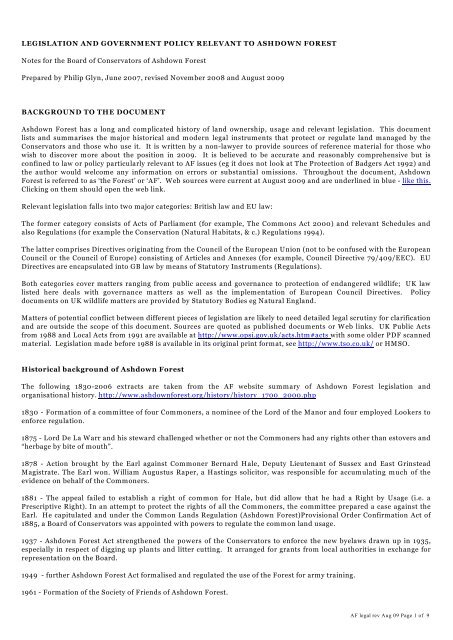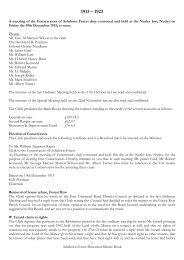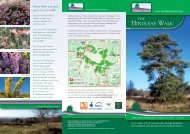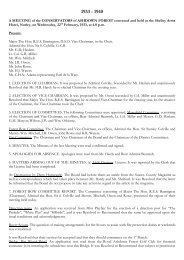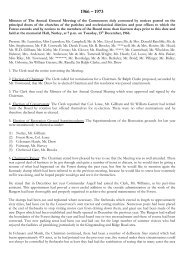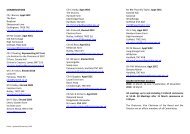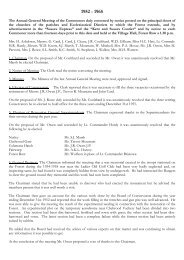Current legislation and government policy relevant to Ashdown Forest
Current legislation and government policy relevant to Ashdown Forest
Current legislation and government policy relevant to Ashdown Forest
Create successful ePaper yourself
Turn your PDF publications into a flip-book with our unique Google optimized e-Paper software.
LEGISLATION AND GOVERNMENT POLICY RELEVANT TO ASHDOWN FORESTNotes for the Board of Conserva<strong>to</strong>rs of <strong>Ashdown</strong> <strong>Forest</strong>Prepared by Philip Glyn, June 2007, revised November 2008 <strong>and</strong> August 2009BACKGROUND TO THE DOCUMENT<strong>Ashdown</strong> <strong>Forest</strong> has a long <strong>and</strong> complicated his<strong>to</strong>ry of l<strong>and</strong> ownership, usage <strong>and</strong> <strong>relevant</strong> <strong>legislation</strong>. This documentlists <strong>and</strong> summarises the major his<strong>to</strong>rical <strong>and</strong> modern legal instruments that protect or regulate l<strong>and</strong> managed by theConserva<strong>to</strong>rs <strong>and</strong> those who use it. It is written by a non-lawyer <strong>to</strong> provide sources of reference material for those whowish <strong>to</strong> discover more about the position in 2009. It is believed <strong>to</strong> be accurate <strong>and</strong> reasonably comprehensive but isconfined <strong>to</strong> law or <strong>policy</strong> particularly <strong>relevant</strong> <strong>to</strong> AF issues (eg it does not look at The Protection of Badgers Act 1992) <strong>and</strong>the author would welcome any information on errors or substantial omissions. Throughout the document, <strong>Ashdown</strong><strong>Forest</strong> is referred <strong>to</strong> as ‘the <strong>Forest</strong>’ or ‘AF’. Web sources were current at August 2009 <strong>and</strong> are underlined in blue - like this.Clicking on them should open the web link.Relevant <strong>legislation</strong> falls in<strong>to</strong> two major categories: British law <strong>and</strong> EU law:The former category consists of Acts of Parliament (for example, The Commons Act 2000) <strong>and</strong> <strong>relevant</strong> Schedules <strong>and</strong>also Regulations (for example the Conservation (Natural Habitats, & c.) Regulations 1994).The latter comprises Directives originating from the Council of the European Union (not <strong>to</strong> be confused with the EuropeanCouncil or the Council of Europe) consisting of Articles <strong>and</strong> Annexes (for example, Council Directive 79/409/EEC). EUDirectives are encapsulated in<strong>to</strong> GB law by means of Statu<strong>to</strong>ry Instruments (Regulations).Both categories cover matters ranging from public access <strong>and</strong> governance <strong>to</strong> protection of endangered wildlife; UK lawlisted here deals with governance matters as well as the implementation of European Council Directives. Policydocuments on UK wildlife matters are provided by Statu<strong>to</strong>ry Bodies eg Natural Engl<strong>and</strong>.Matters of potential conflict between different pieces of <strong>legislation</strong> are likely <strong>to</strong> need detailed legal scrutiny for clarification<strong>and</strong> are outside the scope of this document. Sources are quoted as published documents or Web links. UK Public Actsfrom 1988 <strong>and</strong> Local Acts from 1991 are available at http://www.opsi.gov.uk/acts.htm#acts with some older PDF scannedmaterial.Legislation made before 1988 is available in its original print format, see http://www.tso.co.uk/ or HMSO.His<strong>to</strong>rical background of <strong>Ashdown</strong> <strong>Forest</strong>The following 1830-2006 extracts are taken from the AF website summary of <strong>Ashdown</strong> <strong>Forest</strong> <strong>legislation</strong> <strong>and</strong>organisational his<strong>to</strong>ry. http://www.ashdownforest.org/his<strong>to</strong>ry/his<strong>to</strong>ry_1700_2000.php1830 - Formation of a committee of four Commoners, a nominee of the Lord of the Manor <strong>and</strong> four employed Lookers <strong>to</strong>enforce regulation.1875 - Lord De La Warr <strong>and</strong> his steward challenged whether or not the Commoners had any rights other than es<strong>to</strong>vers <strong>and</strong>“herbage by bite of mouth”.1878 - Action brought by the Earl against Commoner Bernard Hale, Deputy Lieutenant of Sussex <strong>and</strong> East GrinsteadMagistrate. The Earl won. William Augustus Raper, a Hastings solici<strong>to</strong>r, was responsible for accumulating much of theevidence on behalf of the Commoners.1881 - The appeal failed <strong>to</strong> establish a right of common for Hale, but did allow that he had a Right by Usage (i.e. aPrescriptive Right). In an attempt <strong>to</strong> protect the rights of all the Commoners, the committee prepared a case against theEarl. He capitulated <strong>and</strong> under the Common L<strong>and</strong>s Regulation (<strong>Ashdown</strong> <strong>Forest</strong>)Provisional Order Confirmation Act of1885, a Board of Conserva<strong>to</strong>rs was appointed with powers <strong>to</strong> regulate the common l<strong>and</strong> usage.1937 - <strong>Ashdown</strong> <strong>Forest</strong> Act strengthened the powers of the Conserva<strong>to</strong>rs <strong>to</strong> enforce the new byelaws drawn up in 1935,especially in respect of digging up plants <strong>and</strong> litter cutting. It arranged for grants from local authorities in exchange forrepresentation on the Board.1949 - further <strong>Ashdown</strong> <strong>Forest</strong> Act formalised <strong>and</strong> regulated the use of the <strong>Forest</strong> for army training.1961 - Formation of the Society of Friends of <strong>Ashdown</strong> <strong>Forest</strong>.AF legal rev Aug 09 Page 1 of 9
1974 - Most recent <strong>Ashdown</strong> <strong>Forest</strong> Act.1988 - Purchase of the <strong>Forest</strong> from Earl De La Warr by East Sussex County Council.1994 - Purchase of sixty-nine acres of woodl<strong>and</strong> at Chelwood Vachery.1996 - <strong>Forest</strong> designated a Special Protection Area, further conserving the bird life.1996-1998 - Phased fencing <strong>and</strong> re-introduction of grazing <strong>to</strong> 1300 acres on the south/west chases.2001 - <strong>Forest</strong> designated a Special Area of Conservation <strong>to</strong> help conserve vulnerable habitats. <strong>Forest</strong> entirely closed forsix weeks due <strong>to</strong> Foot <strong>and</strong> Mouth Disease precautions.2006 – August; HLS agreement signed.....................................................................................................................................................The following paragraphs chronologically list <strong>and</strong> provide notes on Acts of Parliament, EU directives <strong>and</strong> <strong>government</strong><strong>policy</strong> that are believed <strong>to</strong> have a bearing on <strong>Ashdown</strong> <strong>Forest</strong>:Commons Act 1876This sets out the provision for inclosure (sic) under the Inclosure Acts 1845 <strong>to</strong> 1868, whereby the Inclosure Commissionersmay, by provisional order, authorise the inclosure of a common, provided they are satisfied that, among other things, thepublic interest is protected, <strong>and</strong> provided they have regard <strong>to</strong> ‘the benefit of the neighbourhood’.36 commons in Engl<strong>and</strong> <strong>and</strong> Wales are or were regulated under the Commons Act 1876. The Act enabled commons <strong>to</strong> beregulated or inclosed (sic) by means of an Order that generally provided for management <strong>to</strong> be assigned <strong>to</strong> a Board ofConserva<strong>to</strong>rs, twenty or more of which remain <strong>to</strong>day.http://www.defra.gov.uk/wildlife-countryside/protected-areas/common-l<strong>and</strong>/acts.htmhttp://www.opsi.gov.uk/acts/en2006/2006en26.htm.....................................................................................................................................................<strong>Ashdown</strong> <strong>Forest</strong> Act 1885 - the full title is the ‘Common L<strong>and</strong>s Regulation (<strong>Ashdown</strong> <strong>Forest</strong>) Provisional OrderConfirmation Act of 1885'This Act established a Board of Conserva<strong>to</strong>rs viz. 12 elected Commoners plus a representative of the Lord of the Manor(Earl De La Warr). It provided the power <strong>to</strong> make <strong>and</strong> oversee <strong>Forest</strong> bye-laws, protect the rights of <strong>and</strong> regulate thenumbers <strong>and</strong> activities of Commoners <strong>and</strong> preserve the <strong>Forest</strong> in its natural state. Many small, previously illegal,enclosures were recognized.The three subsequent <strong>Ashdown</strong> <strong>Forest</strong> Acts of 1937, 1949 <strong>and</strong> 1974 further strengthened the powers of the Conserva<strong>to</strong>rs <strong>to</strong>enforce new bye-laws, formalised <strong>and</strong> regulated the use of the <strong>Forest</strong> for army training <strong>and</strong> arranged for grants from localauthorities in exchange for representation on the Board.http://www.ashdownforest.org/his<strong>to</strong>ry/his<strong>to</strong>ry_1700_2000.phpIn 1893 the Law of Commons Amendment Act was passed. This was designed <strong>to</strong> prevent owners of common l<strong>and</strong>circumventing the 1876 act by reliance on the Statute of Mer<strong>to</strong>n (the Commons Act 1236) which allowed them <strong>to</strong> inclosethe common provided that they left a sufficiency for the freehold tenants.http://www.opsi.gov.uk/RevisedStatutes/Acts/ukpga/1893/cukpga_18930057_en_1http://www.defra.gov.uk/wildlife-countryside/pdf/protected-areas/common-l<strong>and</strong>/com-order1.pdf.....................................................................................................................................................Commons Act 1899This enables District Councils <strong>to</strong> manage commons where their use for exercise <strong>and</strong> recreation is the prime consideration<strong>and</strong> where the owner <strong>and</strong> commoners do not require a direct voice in the management, or where the owner cannot befound.AF legal rev Aug 09 Page 2 of 9
http://www.defra.gov.uk/wildlife-countryside/protected-areas/common-l<strong>and</strong>/acts.htm.....................................................................................................................................................National Parks <strong>and</strong> Access <strong>to</strong> the Countryside Act 1949This Act gave powers <strong>to</strong> Natural Engl<strong>and</strong> (then called the Nature Conservancy) <strong>to</strong> designate Sites of Special ScientificInterest (SSSIs) <strong>and</strong> National Nature Reserves (NNRs), <strong>and</strong> <strong>to</strong> local authorities <strong>to</strong> designate Local Nature Reserves(LNRs).http://www.opsi.gov.uk/RevisedStatutes/Acts/ukpga/1949/cukpga_19490097_en_1<strong>Ashdown</strong> <strong>Forest</strong> reasons for notification: http://www.sssi.naturalengl<strong>and</strong>.org.uk/citation/citation_pho<strong>to</strong>/1001983.pdf.....................................................................................................................................................The Commons Registration Act 1965The registration authorities' duties <strong>and</strong> responsibilities are set out in the 1965 Act, <strong>and</strong> in regulations made under the Act.These responsibilities are be replaced by those set out in Part I of the Commons Act 2006.http://www.defra.gov.uk/wildlife-countryside/protected-areas/common-l<strong>and</strong>/reg-authority.htmhttp://www.opsi.gov.uk/RevisedStatutes/Acts/ukpga/1965/cukpga_19650064_en_1.....................................................................................................................................................Countryside Act 1968The 1968 Act empowered the Secretary of State <strong>to</strong> make grants <strong>to</strong> local authorities for Country Parks <strong>and</strong> amended the1949 Act <strong>to</strong> allow grants payable under that Act <strong>to</strong> be dealt with in the same way as grants made under the 1968 Act. Thememor<strong>and</strong>um sets out the terms <strong>and</strong> conditions for payments under the two Acts in respect of expenditure on thefollowing: National Parks l<strong>and</strong> <strong>and</strong> areas of outst<strong>and</strong>ing natural beauty; the establishment of country parks <strong>and</strong> facilitiestherein; the countryside generally (including the above) <strong>and</strong> long distance routes.http://www.opsi.gov.uk/RevisedStatutes/Acts/ukpga/1968/cukpga_19680041_en_1.....................................................................................................................................................Local Government Act 1972Reformed the organisation of local <strong>government</strong>, including ESCC. Laid down st<strong>and</strong>ing orders for regulating Councilprocedureshttp://opsi.gov.uk/RevisedStatutes/Acts/ukpga/1972/cukpga_19720070_en_1.....................................................................................................................................................<strong>Ashdown</strong> <strong>Forest</strong> Act 1974This is the most recent <strong>legislation</strong> specifically about <strong>Ashdown</strong> <strong>Forest</strong> that covers its finance <strong>and</strong> the duties of its Board ofConserva<strong>to</strong>rs. All Board members are provided with a printed copy of this but the lines below highlight major points.Section references are in brackets.http://www.ashdownforest.org/docs/<strong>Ashdown</strong>_<strong>Forest</strong>_Act%201974.pdf(15) The Clerk ... shall prepare <strong>and</strong> keep a register of the commoners ...(16) It shall be the duty of the Conserva<strong>to</strong>rs at all times as far as possible <strong>to</strong> regulate <strong>and</strong> manage the <strong>Forest</strong> as an amenity<strong>and</strong> place of resort subject <strong>to</strong> the existing rights of common <strong>and</strong> <strong>to</strong> protect such rights of common, <strong>to</strong> protect the forestfrom encroachments <strong>and</strong> <strong>to</strong> conserve it as a quiet <strong>and</strong> natural area of outst<strong>and</strong>ing beauty.(17) The Conserva<strong>to</strong>rs have the power <strong>to</strong>:subject <strong>to</strong> the consent of the lord of the manor .... engage in all manner of tree conservation, including planting, fellingcutting <strong>and</strong> lopping of trees <strong>and</strong> shrubs...AF legal rev Aug 09 Page 3 of 9
protect any part of the forest <strong>and</strong> ... erect fences therefor;conserve the fauna <strong>and</strong> flora <strong>and</strong> ... improve grazing;conserve those parts of the forest which are of his<strong>to</strong>rical, archaeological <strong>and</strong> physiographical interest;provide <strong>and</strong> maintain vehicles, plant ... <strong>and</strong> buildings ...;provide <strong>and</strong> maintain recreational facilities which ... do not involve the erection of new buildings ... of any kind ...;make, provide, maintain <strong>and</strong> extend car parking places for vehicles ....;appoint officers <strong>and</strong> staff for the purpose of more efficiently <strong>and</strong> properly carrying out the duties of the Conserva<strong>to</strong>rs...;(20) The Conserva<strong>to</strong>rs may acquire by agreement ... purchase, exchange, lease, gift or otherwise any l<strong>and</strong> within or outsidethe forest, <strong>and</strong> hold such l<strong>and</strong> as part of the <strong>Forest</strong>...... sell ... let or mortgage any l<strong>and</strong> held by them.(21) ...the public shall have access on foot <strong>to</strong> the <strong>Forest</strong> for quiet recreation <strong>and</strong> enjoyment.(24 <strong>and</strong> 25) East Sussex County Council <strong>and</strong> Wealden District Council should meet the expenses of the Conserva<strong>to</strong>rs in sofar as such expenses are not defrayed by the proceeds of the rate levied on the Commoners <strong>and</strong> out of other income.Section 19 of the Act allows the Conserva<strong>to</strong>rs <strong>to</strong> ‘make, alter or repeal byelaws for the regulation <strong>and</strong> better administrationof the forest’. http://www.defra.gov.uk/wildlife-countryside/pdf/access/byelaw-cr1.pdf.....................................................................................................................................................East Sussex Act 1981Section 89 of this lengthy Act, covering many procedural matters in the County administration, replaces the option ofproxy vote for election of AF conserva<strong>to</strong>rs with postal votes......................................................................................................................................................The Wildlife <strong>and</strong> Countryside Act 1981This is still the major legal instrument for wildlife protection in Britain, although other significant Acts have been passedsince. It has numerous parts <strong>and</strong> supplementary lists <strong>and</strong> schedules many of which have been amended since publication;it was amended in 1985 <strong>and</strong> 1991 <strong>and</strong> schedules amended 1988, 1991, 1992 <strong>and</strong> 1998. It is therefore often referred <strong>to</strong> as‘The Wildlife <strong>and</strong> Countryside Act 1981 (as amended)’.This <strong>legislation</strong> is the means by which the Convention on the Conservation of European Wildlife <strong>and</strong> Natural Habitats (the'Bern Convention') <strong>and</strong> the European Union Directives on the Conservation of Wild Birds (79/409/EEC) <strong>and</strong> NaturalHabitats <strong>and</strong> Wild Fauna <strong>and</strong> Flora (92/43/FFC) (see below) are implemented in Great Britain see Statu<strong>to</strong>ryInstrument 1994 No. 2716 below.* Part I is concerned with the protection of wild plants <strong>and</strong> animals* Part II relates <strong>to</strong> the countryside <strong>and</strong> national parks (<strong>and</strong> the designation of protected areas),* Part III covers public rights of way,* Part IV deals with miscellaneous provisions of the Act ie prevention of release of non-native plants or animalshttp://www.jncc.gov.uk/page-1377http://www.uk-<strong>legislation</strong>.hmso.gov.uk/RevisedStatutes/Acts/ukpga/1981/cukpga_19810069_en_1http://www.naturenet.net/law/wcagen.html#other.....................................................................................................................................................Road Traffic Act 1988Section 34 prohibits driving off road vehicles without lawful authority on l<strong>and</strong> not forming part of a road. It also prohibitsdriving without lawful authority on<strong>to</strong> or upon any common l<strong>and</strong>, moorl<strong>and</strong> or l<strong>and</strong> of any other description not being par<strong>to</strong>f a road.http://www.opsi.gov.uk/acts/acts1988/Ukpga_19880052_en_1.....................................................................................................................................................AF legal rev Aug 09 Page 4 of 9
STRATEGIC PLAN FOR THE CONVENTION ON BIOLOGICAL DIVERSITYAt the 1992 Earth Summit in Rio de Janeiro, world leaders agreed on a comprehensive strategy for "sustainabledevelopment". One of the key agreements was the Convention on Biological Diversity. The Convention establishedthree main goals:• the conservation of biological diversity• the sustainable use of its components• the fair <strong>and</strong> equitable sharing of the benefits from the use of genetic resources.In 2002, 10 years after the Convention on Biological Diversity was opened for signature, the Parties developed a StrategicPlan <strong>to</strong> guide its further implementation at the national, regional <strong>and</strong> global levels.The purpose was <strong>to</strong> halt effectively the loss of biodiversity so as <strong>to</strong> secure the continuity of its beneficial uses through theconservation <strong>and</strong> sustainable use of its components <strong>and</strong> the fair <strong>and</strong> equitable sharing of benefits arising from the use ofgenetic resources.In decision VI/26 The Conference of the Parties <strong>to</strong>ok note of the conclusions of the Seychelles Workshop on the StrategicPlan <strong>and</strong> the report of the Open-ended Inter-Sessional Meeting on the Strategic Plan, National Reports <strong>and</strong>Implementation of the Convention on Biological Diversity (19 - 21 November 2001, Montreal, Canada) <strong>and</strong> adopted aStrategic Plan for the Convention on Biological Diversity.2010 Biodiversity TargetIn April 2002, the Parties <strong>to</strong> the Convention committed themselves <strong>to</strong> achieve by 2010 a significant reduction of thecurrent rate of biodiversity loss at the global, regional <strong>and</strong> national level as a contribution <strong>to</strong> poverty alleviation <strong>and</strong> <strong>to</strong> thebenefit of all life on Earth.This target was subsequently endorsed by the World Summit on Sustainable Development <strong>and</strong> the United Nations GeneralAssembly <strong>and</strong> was incorporated as a new target under the Millennium Development Goals.http://www.cbd.int/sp/default.shtml.....................................................................................................................................................UK Public Service Agreement Targets on SSSIsThere are 4,111 Sites of Special Scientific Interest (SSSIs) in Engl<strong>and</strong> covering 1,076,704 ha. Defra has a Public ServiceAgreement (PSA) target <strong>to</strong> have at least 95% of the SSSI area in recovering or favourable condition (FC) by 2010. TheDepartmental Report states that 67.4% of SSSIs were in target condition in March 2005, an increase of 4.5% from March2004.http://www.publications.parliament.uk/pa/cm200506/cmselect/cmenvfru/693/69308.htm.....................................................................................................................................................1979 Birds DirectiveCouncil Directive 79/409/EEC of 2 April 1979 on the conservation of wild birds - 19 ArticlesThe Declaration of 22 November 1973 on the Programme of Action of the European Communities on the Environmentcalls for specific action <strong>to</strong> protect birds, supplemented by a resolution on 17 May 1977 on the continuation <strong>and</strong>implementation of European community <strong>policy</strong> <strong>and</strong> its action programme on the environment.http://ec.europa.eu/environment/nature/<strong>legislation</strong>/birdsdirective/index_en.htm.....................................................................................................................................................AF legal rev Aug 09 Page 5 of 9
1992 EC Habitats Directivehttp://www.proact-campaigns.net/info<strong>and</strong>links/id10.htmlIn 1992 the European Community adopted Council Directive 92/43/EEC on the Conservation of natural habitats <strong>and</strong>of wild fauna <strong>and</strong> flora (EC Habitats Directive). The Directive contains 24 Articles <strong>and</strong> is the means by which theCommunity meets its obligations as a signa<strong>to</strong>ry of the Convention on the Conservation of European Wildlife <strong>and</strong>Natural Habitats (Bern Convention). Member States are required <strong>to</strong> protect species listed in Annexes; moni<strong>to</strong>rhabitats <strong>and</strong> species <strong>and</strong> report every six years on implementation.The 189 habitats listed in Annex I <strong>and</strong> the 788 species in Annex II are <strong>to</strong> be protected by means of a network of sites, eachState proposing sites for evaluation <strong>to</strong> form a European network of Sites of Community Importance (SCIs),designated as Special Areas of Conservation (SACs).These, with Special Protection Areas (SPAs) under the EC Birds Directive, form a network of protected areas knownas Natura 2000.The Directive was amended in 1997 by a technical adaptation Directive. The annexes were further amended by theEnvironment Chapter of the Treaty of Accession 2003.The Habitats Directive introduces the precautionary principle that projects can only be allowed after judging that thereare no adverse effects on the integrity of the site.Projects may still be permitted if there are no alternatives <strong>and</strong> there are imperative reasons of overriding public interest.In such cases compensation measures will be necessary <strong>to</strong> ensure the overall integrity of network of sites. These measuresalso apply <strong>to</strong> SPAs.Member States shall also encourage the management of features of the l<strong>and</strong>scape <strong>to</strong> support the Natura 2000 network.In the UK the Directive has been transposed in<strong>to</strong> national laws by means of the Conservation (Natural Habitats, &c.) Regulations 1994 (as amended), known as 'The Habitats Regulations'.Most SACs on l<strong>and</strong> or freshwater areas are underpinned by notification as Sites of Special Scientific Interest (SSSIs). Inthe case of SACs that are not notified as SSSI, positive management is promoted by wider countryside measures, whileprotection relies on the provisions of the Habitats Regulations.The site list for the Atlantic Biogeographical Region (which includes the UK) was formally adopted by the Commission inDecember 2004. The UK's first SACs were subsequently designated in Wales in December 2004, in Scotl<strong>and</strong> in March2005, <strong>and</strong> in Engl<strong>and</strong> in April 2005.The Joint Nature Conservation Committee (JNCC) advises <strong>government</strong> on the application <strong>and</strong> interpretation of theDirective, including the sites that meet the criteria for consideration as SCIs.http://www.jncc.gov.uk/<strong>Ashdown</strong> <strong>Forest</strong> SPA : http://www.jncc.gov.uk/default.aspx?page=2052<strong>Ashdown</strong> <strong>Forest</strong> SAC : http://www.jncc.gov.uk/protectedsites/sacselection/SAC.asp?EUCode=UK0030080.....................................................................................................................................................Statu<strong>to</strong>ry Instrument 1994 No. 2716The Conservation (Natural Habitats, &c.) Regulations 1994These Regulations make provision for the purpose of implementing, for Great Britain, Council Directive 92/43/EECIt describes the pro<strong>to</strong>col for selection of sites <strong>and</strong> the designation of Special Areas of Conservation <strong>and</strong> establishespriorities for the designation of sites.http://www.opsi.gov.uk/SI/si1994/Uksi_19942716_en_1.htm.....................................................................................................................................................AF legal rev Aug 09 Page 6 of 9
Protection of NATURA 2000 sitesThe text of Article 6.4 of the Habitats Directive 92/43/EEC"If, in spite of a negative assessment of the implications for the site <strong>and</strong> in the absence of alternative solutions, a plan orproject must nevertheless be carried out for imperative reasons of overriding public interest, including those of a social oreconomic nature, the Member State shall take all compensa<strong>to</strong>ry measures necessary <strong>to</strong> ensure that the overall coherenceof Natura 2000 is protected. It shall inform the Commission of the compensa<strong>to</strong>ry measures adopted. Where the siteconcerned hosts a priority natural habitat type <strong>and</strong>/or a priority species, the only considerations which may be raised arethose relating <strong>to</strong> human health or public safety, <strong>to</strong> beneficial consequences of primary importance for the environment or,further <strong>to</strong> an opinion from the Commission, <strong>to</strong> other imperative reasons of overriding public interest".This provides for exceptional circumstances but emphasises the international importance given <strong>to</strong> NATURA 2000 siteshttp://eur-lex.europa.eu/LexUriServ/LexUriServ.do?uri=CELEX:31992L0043:EN:HTMLhttp://www.proact-campaigns.net/info<strong>and</strong>links/id10.html.....................................................................................................................................................Local Government Act 2000Part I: introduced a new power for local authorities <strong>to</strong> promote the economic, social or environmental well-being of anarea.Part II: required that all local authorities move away from the traditional committee style of decision-making, where allmembers had a formal decision making role, <strong>to</strong> one of four executive models ie, leader or cabinet, mayor or cabinet, mayoror council manager, or alternative arrangements.Part III: introduced a new ethical framework for councils, including a requirement <strong>to</strong> adopt a code of conduct formembers <strong>and</strong> implement a st<strong>and</strong>ards committee. The general functions of the st<strong>and</strong>ards committee are <strong>to</strong> promote <strong>and</strong>maintain high st<strong>and</strong>ards of conduct within the local authority <strong>and</strong> <strong>to</strong> assist members of the authority <strong>to</strong> observe the codeof conduct.http://www.opsi.gov.uk/Acts/acts2000/ukpga_20000022_en_1http://www.idea.gov.uk/idk/core/page.do?pageId=73225.....................................................................................................................................................Countryside <strong>and</strong> Rights of Way Act CRoW 2000This Act provides a new right of public access on foot <strong>to</strong> areas of open l<strong>and</strong>, eg mountain, moor, heath, down <strong>and</strong>registered common l<strong>and</strong>. Since the 1974 <strong>Ashdown</strong> <strong>Forest</strong> Act states ‘The public shall have access on foot <strong>to</strong> the <strong>Forest</strong> forquiet recreation <strong>and</strong> enjoyment.’ this is not a new right for <strong>Ashdown</strong> <strong>Forest</strong>.It places a duty on Government Departments <strong>to</strong> have regard for the conservation of biodiversity <strong>and</strong> maintain lists ofspecies <strong>and</strong> habitats for which conservation steps should be taken or promoted, in accordance with the Convention onBiological Diversity.It renames the Nature Conservancy Council - English Nature (later renamed again ‘Natural Engl<strong>and</strong>’)It increases protection for Sites of Special Scientific Interest (SSSI) <strong>and</strong> strengthens wildlife enforcement <strong>legislation</strong>including legal enforcement. If Natural Engl<strong>and</strong> refuse <strong>to</strong> give consent <strong>to</strong> an operation that may damage the specialfeatures of a SSSI, that operation may not legally take place.It requires local authorities <strong>to</strong> produce management plans for each Area of Outst<strong>and</strong>ing Natural Beauty (AONB).It enables the creation of Conservation Boards <strong>to</strong> assume responsibility for AONBs, particularly where the l<strong>and</strong> designatedcrosses several local authority jurisdictions.The Act also requires all <strong>relevant</strong> authorities <strong>to</strong> have regard <strong>to</strong> the purpose of conserving <strong>and</strong> enhancing the natural beautyof AONBs when performing their functions.http://www.jncc.gov.uk/page-1378http://www.opsi.gov.uk/acts/acts2000/20000037.htmAF legal rev Aug 09 Page 7 of 9
http://www.english-nature.org.uk/special/sssi/protection.cfmhttp://www.naturalengl<strong>and</strong>.org.uk/ourwork/conservation/designatedareas/sssi/importance.aspx.....................................................................................................................................................Commons Act 2006This Act enables Commons Councils <strong>to</strong> be set up with powers <strong>to</strong> regulate grazing <strong>and</strong> other agricultural activities. Defrawas looking <strong>to</strong> bring this part of the Act in<strong>to</strong> force in late 2007.The Act enables "missed" commons <strong>to</strong> be registered <strong>and</strong> enables wrongly registered l<strong>and</strong> <strong>to</strong> be deregistered through anoverhaul of the registration system for common l<strong>and</strong> (<strong>and</strong> <strong>to</strong>wn <strong>and</strong> village greens).It sets out new criteria for the registration of <strong>to</strong>wn or village greens.It prohibits the severance of common rights, preventing commoners from selling, leasing or letting their rights away fromthe property <strong>to</strong> which rights are attached. The Act prohibits the severance of rights with effect from 28 June 2005.Defra states that it provides better protection for common l<strong>and</strong> <strong>and</strong> greens by streamlining the consents system for works<strong>and</strong> fencing on commons <strong>and</strong> ensures that existing statu<strong>to</strong>ry protections are applied consistently. This includesreinforcing existing protections against abuse, encroachment <strong>and</strong> unauthorised development. Lengthy consultationpapers covering fundamental governance, public engagement <strong>and</strong> administrative points have been provided <strong>to</strong> AF. Itpotentially complicates management activities on AF <strong>and</strong> clarification is still being sought.http://www.defra.gov.uk/wildlife-countryside/protected-areas/common-l<strong>and</strong>/index.htmhttp://www.opsi.gov.uk/acts/acts2006/20060026.htm.....................................................................................................................................................The Natural Environment <strong>and</strong> Rural Communities Act (NERC) 2006In 2004 following the review of ‘rural delivery’ carried out by Lord Haskins, Defra published its Rural Strategy.NERC 2006 established Natural Engl<strong>and</strong> (NE), an independent statu<strong>to</strong>ry Non-Departmental Public Body (NDPB), formedby merging the Countryside Agency's l<strong>and</strong>scape, access <strong>and</strong> recreation functions with the activities of English Nature <strong>and</strong>the larger part of the Rural Development Service (RDS).NE describes itself as: “Here <strong>to</strong> conserve <strong>and</strong> enhance the natural environment, for its intrinsic value, the wellbeing <strong>and</strong>enjoyment of people <strong>and</strong> the economic prosperity that it brings.”The Act also covers the illegal use of byways by mo<strong>to</strong>r vehicles by putting an end <strong>to</strong> claims for mo<strong>to</strong>r vehicle access on thebasis of his<strong>to</strong>rical use by horse-drawn vehicles.It provides powers for the Secretary of State <strong>to</strong> fund activities directly within Defra's remit <strong>and</strong> <strong>to</strong> allow both the Secretaryof State, <strong>and</strong> designated bodies, <strong>to</strong> delegate Environment, Food <strong>and</strong> Rural Affairs (EFRA) functions <strong>to</strong> one another(although regula<strong>to</strong>ry <strong>and</strong> enforcement functions cannot be delegated <strong>to</strong> private bodies).The explana<strong>to</strong>ry notes alone run <strong>to</strong> 42 pages. http://www.opsi.gov.uk/acts/en2006/ukpgaen_20060016_en.pdfhttp://www.defra.gov.uk/wildlife-countryside/access/prow/nerc06.htmhttp://www.opsi.gov.uk/acts/acts2006/20060016.htm.....................................................................................................................................................Natural Engl<strong>and</strong>'s SSSI Enforcement Policy StatementCRoW 2000 provides additional legal powers <strong>to</strong> NE <strong>to</strong> ‘ensure better protection <strong>and</strong> management of SSSIs <strong>and</strong> safeguardtheir existence in<strong>to</strong> the future’.The following are extracts from http://www.naturalengl<strong>and</strong>.org.uk/Images/enforcement<strong>policy</strong>_tcm6-11871.pdf“Natural Engl<strong>and</strong> has direct enforcement responsibilities for the investigation of breaches of regulation <strong>and</strong> a duty <strong>to</strong>AF legal rev Aug 09 Page 8 of 9
apply its regula<strong>to</strong>ry powers <strong>to</strong> address offences relating <strong>to</strong>: Sites of Special Scientific Interest; heather <strong>and</strong> grassl<strong>and</strong>burning ....”<strong>and</strong>“Natural Engl<strong>and</strong> aims <strong>to</strong> prevent harm <strong>to</strong> the natural environment. It will use all its regula<strong>to</strong>ry levers, includingproviding advice, guidance <strong>and</strong> l<strong>and</strong> management incentive schemes, <strong>to</strong> encourage compliance with the law <strong>and</strong> ensurethat the natural environment is conserved, enhanced, protected <strong>and</strong> res<strong>to</strong>red. ”<strong>and</strong> from http://www.naturalengl<strong>and</strong>.org.uk/ourwork/conservation/designatedareas/sssi/publicbodyinvolvement.aspx“It is an offence for public bodies <strong>to</strong> carry out, or permit operations on SSSIs that are likely <strong>to</strong> affect its special interest,without first consulting us. Failing <strong>to</strong> follow this process is a criminal offence which may result in a fine <strong>and</strong> ares<strong>to</strong>ration order.”....................................................................................................................................................Statu<strong>to</strong>ry Instrument 1159: The Local Authorities (Model Code of Conduct) Order 2007This sets out st<strong>and</strong>ards of conduct for members of Local Authorities, eg ESCC Councillors appointed <strong>to</strong> the AF Board <strong>and</strong>is referred <strong>to</strong> in current AF St<strong>and</strong>ing Ordershttp://www.opsi.gov.uk/si/si2007/uksi_20071159_en_1.....................................................................................................................................................Philip Glynpjglyn@gmail.comAugust 2009AF legal rev Aug 09 Page 9 of 9


